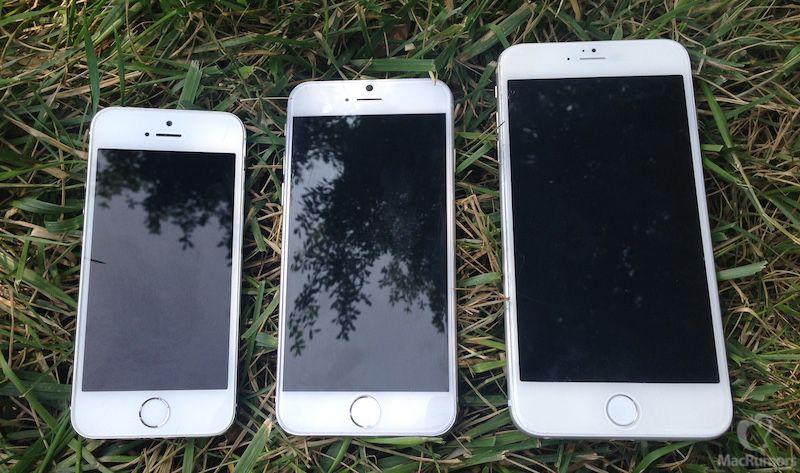
What We Expect
Apple's new iPhone 6 devices will be introduced at a September 9 media event at the Flint Center, the same location where Apple debuted the original Mac 30 years ago. An overwhelming number of iPhone 6 rumors and part leaks have given us a near-complete look at the two devices ahead of their launch.
With the iPhone 5, Apple increased the screen size of the device from 3.5 inches to 4 inches, and with the iPhone 6, the phone's display is going to grow even larger. Though Apple experimented with a range of screen sizes, the company settled on 4.7 inches and 5.5 inches for its two devices, which will bring the next iPhone in line with competing Android and Windows phones that have adopted larger displays.
Over the course of the last several years, consumer preference has shifted towards bigger screens, and Apple is now prepared to meet consumer demand for larger devices.
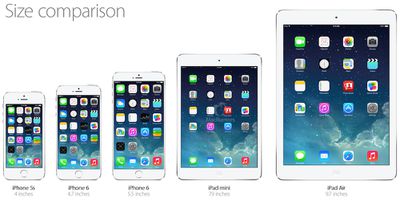 Rumored sizes of the new iPhone 6 compared to iPhone 5, iPad mini, iPad air
Rumored sizes of the new iPhone 6 compared to iPhone 5, iPad mini, iPad air
Along with a larger screen, both models of the iPhone 6 are expected to adopt design elements from the iPad and the iPod touch. Alleged iPhone 6 schematics and part leaks have suggested the iPhone 6 will be considerably thinner than the current iPhone 5s, which is 7.6 mm. The final version of the 4.7-inch iPhone 6 is said to be 6.9 mm thick, 138 mm long, and 66 mm wide. The 5.5-inch iPhone 6 is said to be 7.1 mm thick, 158 mm long, and 78 mm wide.
The phones will also include rounded iPad-style corners, pill-shaped volume buttons, thick antenna bands, a rounded True Tone dual-LED flash, an embedded Apple logo, and a power button located on the right side of the device. According to new reports, the devices may be called the "iPhone 6" and the "iPhone 6 Plus".
Rumors have suggested at least some models of the iPhone 6 might feature a durable sapphire display and both the 4.7 and 5.5-inch iPhone 6 are expected to see camera improvements. The larger 5.5-inch iPhone 6 might incorporate Optical Image Stabilization as a differentiating feature from the 4.7-inch iPhone 6, and it is also possible that the larger iPhone 6 will be the only model with a 128GB storage capacity, which has been mentioned in rumors and seen in leaked schematics. As a result, the larger phone might have a higher price tag.
Images of a completed logic board have suggested the 4.7-inch iPhone 6 will continue to offer 16GB of storage space at the low end, along with 1GB of RAM, support for NFC, and a Qualcomm MDM9625M LTE Modem that supports speeds of up to 150 Mbps. Specifications for the larger 5.5-inch iPhone remain unknown, but the device will likely include many of the same components.
While Apple is expected to introduce both the 4.7 and 5.5-inch iPhone 6 models at its September event, there has been some disagreement about the launch date of the 5.5-inch iPhone 6. Due to production issues that may or may not be resolved, the larger 5.5-inch iPhone could launch alongside the 4.7-inch version, or at a somewhat later date.
Possible Part Leaks
With less than a month to go until Apple's scheduled September 9 iPhone event, alleged iPhone 6 part leaks are being shared on a daily basis. At this point, we've seen virtually every part of the 4.7-inch iPhone 6 in addition to what's said to be a finished device, giving us a clear look at what we're going to see on stage on Tuesday.
While none of the part leaks shared below can be verified as authentic, they have come from an array of different sources and they match up with previously leaked design schematics and mockups. The high quality of many of the parts depicted in the images and videos also points towards their authenticity, as does their similarity to existing iPhone 5s parts.
Beginning with a video of a working iPhone 6 that surfaced over the weekend, we'll share each part of the iPhone 6 leaked thus far, explaining how all of the pieces fit together to form a complete device and how certain parts reveal clues about the iPhone 6's specifications.
Just ahead of the iPhone 6 announcement, several images and videos of what's said to be a legitimate iPhone 6 surfaced on social media networks. The device in question is depicted running multiple iOS apps, which was not possible on functional clone devices. There are, however, some questions about whether or not it is an actual iPhone 6 or a very well-constructed clone, as there are some design discrepancies visible. Real or not, it provides a good idea of what we can expect from the iPhone 6.
Both the video above and images of the 4.7-inch iPhone 6's front panel assembled with its rear shell have given us a solid look at what the final iPhone 6 design might look like upon release. As can be seen in the photos below, the front panel's slightly tapered edges meld seamlessly into the rounded edges of the rear shell for a sleek, continuous curve.
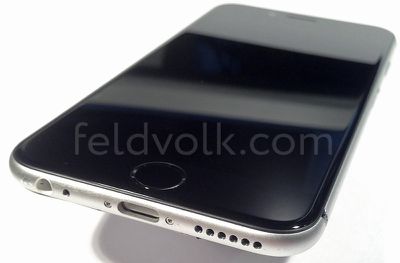
With its softly rounded corners and redesigned pill-shaped volume buttons, the iPhone 6 closely resembles the style of the iPad mini, iPad Air, and newest iPod touch. Shell images also suggest the iPhone 6 will adopt redesigned speaker holes, a round True Tone flash, an embedded Apple logo, and a relocated right-side power button for easier one-handed use.
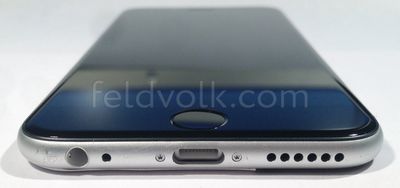
As seen in the image above, the glossy 4.7-inch iPhone 6 front panel has thinner bezels and slightly tapered, rounded edges that will fit tightly with the rear shell.
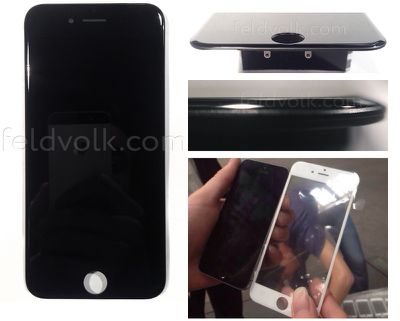
A set of durability tests that involved bending and scratching the front panel suggest that it is highly scratch resistant, but a later scratch test indicated the front panel may not be made of sapphire.
The front panel attaches directly to a display assembly, which has been seen in several different photos thus far. In the image below, for example, the front panel and display assembly is shown, along with the layout of several internal parts including the digitizer/LCD flex cables and earpiece, the front camera, and the proximity/ambient light sensors.

The display assembly includes the backlight panel, which was actually one of the first internal parts to leak. While the panel cannot be confirmed as legitimate, it does appear similar to the backlight panel of the iPhone 5s and it also appears to correspond to a 4.7-inch device. Rumors have suggested Apple will take advantage of advancements in LED backlighting technology to shrink the thickness of the iPhone 6.
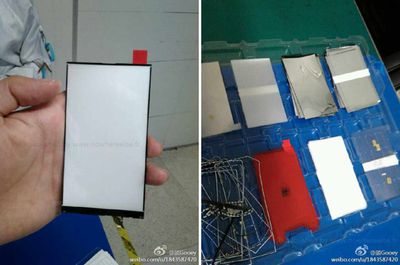
Both the front panel and the display assembly are designed to connect seamlessly to the rear shell of the device, which is what houses many other internal parts including the logic board, battery, Touch ID module, Lightning port assembly, home button, and various flex cables that connect everything together.
Made of thin metal with cutouts for the Apple logo and rear camera, detailed images of the rear shell show the same thick antenna breaks that have been previously seen in iPhone 6 mockups and schematics.

In comparison to the iPhone 5s, measurements of the iPhone 6 casing and leaked schematics suggest the device is significantly thinner, in the range 7mm. The iPhone 5s shell measures in at 7.6mm, with the iPhone 6 doing away with flat edges in favor of a design that more closely resembles the iPod touch.

Recent images said to depict the finished rear shell of the 4.7-inch iPhone 6 have shown the thick antenna bands of the device colored to fit with the rest of the device, making them less obtrusively than the bands seen in previous images.

Along with iPod touch-style rounded corners, the iPhone 6 is expected to take additional design cues from the iPod and the iPad. Part leaks have suggested the iPhone 6 volume/mute buttons and will be elongated and pill-shaped much like those on the iPad, and the iPhone 6 power button is expected to shift from the top of the device to the right hand side in order to make one-handed usage easier.
Recent images have also suggested the volume buttons will be slightly recessed, allowing for a lower profile along the edges and less chance of accidental volume changes.
In the iPhone 5s, a single flex cable powered the volume and power buttons, but iPhone 6 flex cable leaks have pointed towards separate flex cables for the volume buttons and the power button, which is consistent with a shift in the location of the power button.

The mute switch in the iPhone 6 appears to have an entirely new design, pivoting on a pair of internal pins. Previous iPhone mute switches have had a flat slider design and the change may be due to the iPhone 6's rounded sides.

Leaked SIM card trays, which will fit into the iPhone's logic board, point towards potential color options for the iPhone 6, hinting at space gray, silver, and gold. A single SIM card tray had a cobalt blue color, but that part may have been unfinished or not a true iPhone 6 part.

Like the iPad, the iPhone 6 is expected to gain an embedded Apple logo in the rear shell of the device for aesthetic purposes. While early rumors suggested that it might possibly light up, additional part leaks indicate that is not the case. The source that supplied high-quality rear shell images to MacRumors did say, however, that the embedded Apple logo was "very extraordinary," offering a high level of scratch protection.

4.7-inch iPhone 6 rear shell images said to be in the final stages of completion have included a protruding camera ring measuring in at 0.67-0.77mm on the outside of the shell, a new addition that was not seen in earlier images. Initial rumors indicated a protruding camera ring would be necessary for the larger 5.5-inch iPhone 6, but it appears that both versions might possibly include a slightly elevated camera ring, much like the iPod touch. A protruding camera ring has also been seen in alleged 4.7-inch iPhone 6 schematics.

With the iPhone 5s, Apple introduced a pill-shaped dual-LED "True Tone" rear flash to improve the look of photos. It was thought that early iPhone 6 schematics and part leaks might be fake because they did away with the pill-shaped flash, but a leaked image of an iPhone 6 flex cable containing a round flash module has suggested Apple has found a way to create a round dual-LED flash that houses both white and amber LEDs.

The inner bottom of the rear shell will house the Lightning port, the home button, and the Touch ID fingerprint sensor. The iPhone 6 flex cable that powers the Lightning port, the headphone jack, and the microphone has surfaced and it looks very similar to the same part found in the iPhone 5s aside from dual screw holes near the headphone jack. These screws line up with the screw holes found in the iPhone 6 rear shell.

This area will also include the Touch ID fingerprint sensor, which has been seen in leaked images. The Touch ID sensor will be located behind the home button on the front panel, but it will connect via cable to the Lightning assembly housed in the rear shell. The iPhone 6 Touch ID sensor looks similar to the sensor found in the iPhone 5s, but it does have relocated screw holes to fit into the iPhone 6 casing. The Touch ID sensor in the iPhone 6 may be more durable than the iPhone 5s version, due to a new manufacturing process using tin.

Several images of a possible iPhone 6 battery that will be housed in the rear shell of the device have surfaced, first when in production and later during the assembly process. Though unverified (but sporting an Apple logo), one battery said to be for the 4.7-inch iPhone 6 depicted a capacity of 1,810 mAh, a slight increase over the 1,560 mAh battery in the iPhone 5s. Rumors have predicted only modest battery gains for the iPhone 6. Multiple images and a video of a second battery with a capacity of 2,915 mAh have also been spotted, which may be slated for the larger 5.5-inch iPhone 6.

While most of the part leaks have been for the 4.7-inch iPhone, there have been a few specific leaks of internal parts that suggest Apple is indeed working on two separate iPhones in two different sizes.
Images of two separate logic boards have surfaced, which appear to correspond to two new devices. The logic boards are both similar to the iPhone 5s logic board, but slightly larger and unique in design. The screw holes for the logic board on the left appear to correspond with the screw holes in the rear shell of the 4.7-inch iPhone, which would mean the logic board on the far right is destined for the 5.5-inch iPhone 6. This logic board is also slightly larger.

The logic board will fit into the rear shell of the iPhone 6, housing the A8 processor, flash module, touchscreen controller, power management chip, and more, as can be seen in an assembled iPhone 6 logic board below. Though many components are covered by electromagnetic shielding, the SIM slot, connectors for flex cables, a WiFi module, and a flash storage chip from Toshiba are visible.

Detailed examinations of what is said to be the completed logic board for the 4.7-inch iPhone 6 have revealed important details about the device. An NFC chip from NXP confirms that the iPhone 6 will include support for near field communications, while a 16GB flash storage module suggests that the low-end 4.7-inch iPhone 6 will continue to be offered at that capacity.
The A8 chip from the logic board also indicates the device will continue to offer 1 GB of LPDDR3 memory, like the iPhone 5s.

Separate home button and sensor flex cables that also appear to be for two separate iPhones have come from the Asian supply chain as well, further confirming that two different devices are in the works. It is unclear which flex cables are for which device, but it is clear that there are two new variations similar in design to the iPhone 5s cable. These flex cables will connect various internal parts to the logic board allowing them control vital iPhone functions.

Along with the logic boards and flex cables, both an alleged 5.5-inch backlight and a 5.5-inch rear shell have surfaced. The rear shell wasn't spotted until August, suggesting the phone has only just entered production. Screw holes in the 5.5-inch iPhone 6 rear shell match up with screw holes found in previously leaked logic boards, so it is likely to be an authentic part. The rear shell of the 5.5-inch iPhone 6 has also been seen in a video.

In More Detail
Hints of a larger iPhone first surfaced way back in December of 2012, when an analyst noted the existence of iPhone 6 prototypes with a screen size of 4.8 inches. In January 2013, a sketchy rumor suggested Apple would debut a 4.8-inch "iPhone Math" alongside the iPhone 5s, and for short period of time, larger-screened iPhone rumors became attached to the iPhone 5s and a 2013 release, with initial rumors indicating Apple would launch both a smaller and a larger iPhone in 2013.
In February, larger iPhone rumors shifted from the iPhone 5s and solidified around the iPhone 6, which would not launch until 2014. It became clear that Apple's 2013 focus was a less expensive iPhone to go alongside its standard flagship offering, while 2014 development would center around a bigger display.
As focus shifted towards the lower cost iPhone, rumors of the larger iPhone 6 died down until June 2013, when Reuters reported Apple was testing 4.7 and 5.7 inch displays for two iPhones to be released in 2014. Several reports from The Wall Street Journal confirmed that Apple was indeed looking into larger-screened prototypes for its next-generation iPhone and a November 2013 report from Bloomberg pointed towards two iPhones with display sizes of 4.7 inches and 5.5 inches.
Screen Size
Rumors about the screen size of the next iPhone have varied quite a bit as Apple reportedly tested a variety of different prototypes. All of the reports have indicated a size ranging from 4.7 to 5.7 inches, but have most consistently pointed to the two distinct models first highlighted by Bloomberg: 4.7 inches and 5.5 inches.
It is likely that introducing an iPhone in the range of 4.7 to 5.5 inches will involve increasing the resolution of the display, which will require developers to create new images and assets for their apps. When Apple switched from the iPhone 4's 960x640 display to the larger 1136x640 display in the iPhone 5, it was the first time Apple had changed the screen size on the phone since its 2007 launch.
Our competitors have made some significant tradeoffs in many of these areas to ship a larger display. We would not ship a larger display iPhone while these tradeoffs exist. Tim Cook - Q2 2013 Earnings Conference Call
Apple has been cautious about introducing new resolutions in order to minimize device fragmentation for app developers, but an increase in pixel count may be the only way for the company to introduce a much larger phone while retaining a Retina-quality display.
The topic of a possible iPhone 6 resolution is one that has been debated for several months, with notable analyst Ming-Chi Kuo predicting a 1334 x 750 (326 ppi) screen for the 4.7-inch iPhone 6 and a 1920 x 1080 (401 ppi) screen for the 5.5-inch version.
A second theory said to be based on information from within Apple suggests the iPhone 6 will have a pixel-tripled display of 1704 x 960, allowing it to retain the same 16:9 ratio of the iPhone 5/5s/5c. With a 1704 by 960 resolution, the 4.7-inch iPhone 6 would have a pixel density of 416 ppi while the 5.5-inch model would have a density of 356 ppi.
This "3x" display mode, outlined by 9to5Mac and first presented as a possible solution several months back by iMore, takes a base resolution of 568 x 320 (one half of the current iPhone 5/5s/5c resolution of 1136 x 640) and triples it to 1704 x 960. Currently, the iPhone uses a pixel doubling technique (568 x 320 doubled is 1136 x 640) to achieve its Retina display.
One of MacRumors' forum members explored how non-optimized iOS apps might look on the 1704 x 960 screen after the release of the iPhone 6, discovering that 3x scaling of existing 2x assets would cause some loss of detail, but would not look shockingly bad because it only results in a 50% enlargement.
![]()
When Apple transitioned to a Retina display in 2010 with the iPhone 4, older non-optimized graphics were enlarged at 100%, causing quite a bit of pixellation. While developers will want to update their apps quickly for the new resolution that will be introduced with the iPhone 6, unoptimized graphics will look considerably better this time around than they did in 2010 during the move to 2x scaling, leading to a relatively painless transition for consumers.
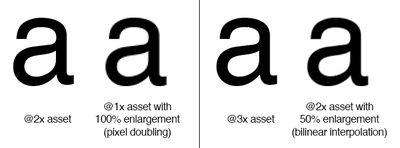
While early rumors suggested a possible resolution of 1704 x 960, new code discovered in the Xcode 6 beta has suggested that at least one of the iPhone 6 devices might have a screen resolution of 1472 x 828.
This resolution is supported by a recent image of the 4.7-inch iPhone 6 display under a microscope, which showed approximately 13 pixels per mm in the horizontal and vertical directions, in line with a 4.7-inch display at a resolution of 1472 x 828.
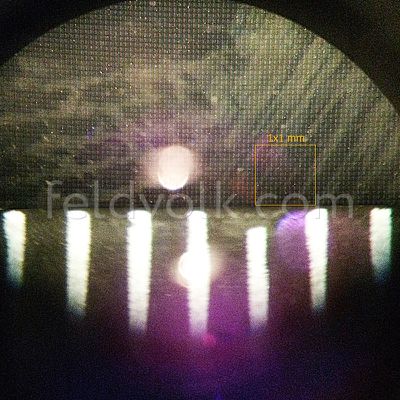
It is possible that the 5.5-inch iPhone 6 will adopt the previously rumored 1704 x 960 resolution, making both of the rumored display sizes accurate. A 4.7-inch iPhone 6 with a resolution of 1472 x 828 and a 5.5-inch iPhone 6 with a resolution of 1704 x 960 would both have a pixel density between 355 to 360 pixels per inch.
Notable Apple blogger John Gruber does not believe Apple will adopt either resolution, however, and he has written an in-depth post speculating on possible resolutions for both the 4.7 and 5.5-inch iPhone 6.
While Gruber says he has no inside knowledge, he believes, based on having done the math, that the a 4.7-inch iPhone 6 will have a resolution of 1334 x 750 with 326 pixels per inch while the 5.5-inch iPhone 6 will have a resolution of 2208 x 1242 with 461 pixels per inch.
A video and images depicting a functional iPhone 6 built from parts appears to support the 1334 x 750 resolution for the 4.7-inch iPhone 6 first proposed by Gruber.
Display Technology
Current iPhones use Low Temperature Poly Silicon (LTPS) technology, and Apple is likely to continue using that technology for the iPhone 6.
With the iPad Air and Retina iPad mini, Apple adopted Indium Gallium Zinc Oxide (IGZO) technology in order to create thinner displays that draw less power than seen with the amorphous silicon (a-Si) displays used on previous models, but LTPS already offers better electron mobility than IGZO and thus Apple will almost certainly continue using LTPS in its smaller iOS devices for the time being.
Glass
Apple currently uses durable and damage resistant Corning Gorilla Glass for its iPhones, but reports have suggested that the company could switch to sapphire crystal for future displays.
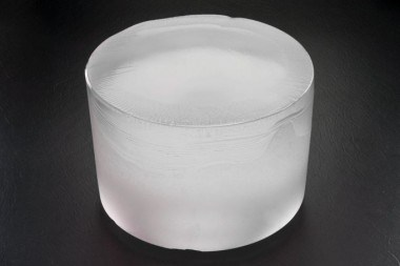
Sapphire crystal, which is currently used for small iPhone elements like the camera lens and the home button of the iPhone 5s, has historically been prohibitively expensive to produce in larger quantities, but Apple has recently partnered with GT Advanced to ramp up sapphire production.
With GT Advanced's technology and Apple's investment, it is possible that the company will be able to produce much larger quantities of sapphire crystal at a far lower cost, which could see Apple incorporating it into next generation devices.
In January of 2014, documents filed with the Foreign-Trade Zone Board indicated that Apple was seeking an "aggressive go-live timeline" for the launch of the sapphire plant in order to begin work on a "critical new sub-component" for Apple devices. While it's unclear what product the sub-component refers to, it could potentially be a sapphire crystal display for the iPhone 6.
Recently revealed documents indicate GT Advanced has purchased 518 sapphire furnace and chamber systems and ordered another 420. With the machines, the Mesa, Arizona sapphire plant has the ability to produce between 100 and 200 million sapphire displays, enough for its entire line of devices. For reference, Apple sold approximately 150 million iPhones in 2013.
Apple has reportedly begun a trial run for an iPhone using a sapphire display cover, with the company ordering 100 of the devices from its assembly partner, Foxconn.
Rumors have disagreed over how Apple plans to use sapphire crystal in its upcoming devices. While some sources have suggested Apple has a limited amount of sapphire to work with and thus may only use the durable material in its higher-end 5.5-inch iPhones, other sources indicate Apple has enough sapphire to use it for the displays of both the 4.7-inch iPhone and the 5.5-inch iPhone, along with the iWatch. The most recent report from The Wall Street Journal has suggested Apple may use sapphire only in the higher-end versions of the 4.7-inch and 5.5-inch iPhone 6. "Higher-end" wasn't defined by the publication, but it likely points towards sapphire displays for higher capacity iPhones, which may also be more expensive due to the use of the material.
Analyst Ming-Chi Kuo believes sapphire may not be a feature of the iPhone 6 at all, having been ruled out due to drop test issues, but a former GT Advanced employee's LinkedIn page seems to suggest Apple is indeed working on devices with sapphire displays.
Design
Initial rumors indicated the iPhone 6 might have a curved display, but more recent rumors suggest the device will continue to have a flat screen much like the iPhone 5s. It may, however, have a slightly tapered glass front panel that allows the display to transition seamlessly into the sides, as described in a report from Nikkei and pictured in a front panel part leak.
Advancements in LED backlighting may allow Apple to design a thinner, lighter iPhone 6. Apple is reportedly shifting from an 0.6mm LED backlight to a thinner 0.4mm model, giving it a bit of extra room to work with. Apple was originally said to be using a single brightness enhancement film (BEF) instead of a dual version as used in the iPhone 5s to cut down on the device's thickness, but a recent rumors have suggested that manufacturing issues have forced Apple to return to a dual film design.
The increased size of the device (or multiple devices) may also give Apple additional room to spread out components, allowing the company to reduce device thickness even further, and it could be nearly as thin as the iPod touch.
Schematics for a 4.7 and 5.7-inch iPhone surfaced in March, from Japanese magazine MacFan. Said to depict the "iPhone 6c," the schematics showed a flat, bezel-free device with several questionable design elements, including a sleep/wake button located on the left-top of the device and single LED-flash not in line with the existing pill-shaped True Tone flash.
Those design drawings were used to create multiple iPhone 6 mockups showing iPod touch-style design elements such as rounded edges and similar microphone holes, along with thick antenna breaks. Multiple parts said to be destined for the iPhone 6 later surfaced with the same general design originally seen in the drawings, suggesting the final iPhone 6 will look very similar to the initial mockups.
Processor Upgrades
The iPhone 5s incorporates a 64-bit A7 28-nanometer chip manufactured by Samsung. Apple's iPhone 6 will reportedly utilize a 20-nanometer A8 chip from TSMC, which will be both smaller and more energy efficient. Samsung will continue to be involved in the production, however, helping to alleviate some of TSMC's manufacturing load.
The A7 chip marked a 31 percent improvement over the A6 in the iPhone 5, and it is likely that the leap to a 20-nm A8 chip will offer similar increases in performance. Initial rumors pointed towards a quad-core 64-bit processor for the A8, but a July report suggested the A8 processor may in fact be dual-core with a frequency of 2.0 GHz or higher per core. The A8 may also be limited to 1GB of RAM, the same as the A7, as evidenced in recent images of a completed logic board.
Supply chain checks conducted by Cowen & Co. analyst Timothy Arcuri have suggested that the 5.5-inch version of the iPhone 6 might include a more powerful processor than the processor found in the 4.7-inch iPhone 6. His checks indicated the chip for the 5.5-inch iPhone may have a larger die, but logic board leaks have suggested that will not be the case.
Apple recently extended its licensing agreement with Imagination Technologies, the company that provides Apple with the PowerVR graphics and video hardware used in iOS devices. It is likely that the next-generation iPhone will continue to feature the Series6 graphics used in the current iPhone 5s, though future devices may receive the Series 6XT PowerVR GPUs which offer a 50 percent benchmark performance increase compared to previous generation cores.
Apple's iPhone 6 may be upgraded with an atmospheric sensor along with its existing M7 motion coprocessor, according to data unearthed in the iOS 8 beta. An atmospheric sensor would potentially be able to measure weather trends and supply altitude data.
Alleged leaked wiring schematics for the iPhone 6 have seemingly confirmed the existence of a barometric pressure sensor, which has a number of applications including GPS and outdoor/indoor navigation enhancement, weather forecasting, altimetry, and spirometry, lung function measurements that were added to Apple's Health app in an iOS 8 beta.
A report from March has also suggested the next iPhone may include temperature and humidity sensors.
Camera Additions
Rumors have disagreed somewhat about the camera improvements that might be found in the iPhone 6, with one rumor pointing towards the continued use of the 8-megapixel sensor currently found in the iPhone 5s and the 5c and a separate rumor suggesting a new 13-megapixel sensor from Sony.
Regardless of which sensor Apple uses, there are also other camera improvements in the works. For example, the iPhone 6 may incorporate Optical Image Stabilization (OIS). Apple has reportedly been working on striking a deal with InvenSense, a company that manufacturers an OIS gyroscope. Optical Image Stabilization uses motion-tracking in order to compensate for device shakiness, allowing for sharper photos and videos.

According to supply chain rumors, Optical Image Stabilization might be limited to the 5.5-inch iPhone 6, due to both production issues and the higher cost of an OIS solution. The 4.7-inch iPhone is still expected to see camera improvements, however, in the form of a new lens module with electronic image stabilization that offers speedier autofocusing.
Other Features
Apple's iPhone 6 is likely to continue to feature the Touch ID fingerprint sensor first found in the iPhone 5s and a recent rumor indicated that TSMC will produce fingerprint sensors for the device, with shipments already in progress.
According to another analyst report, Apple's next-generation iPhone may also support the 802.11ac Wi-Fi standard that first began appearing in Apple products in 2013. 802.11ac, or "Gigabit" Wi-Fi, offers speeds up to three times as fast as existing 802.11n wireless networks, reaching speeds over 1 Gigabit per second. While 802.11ac technology was not quite ready for the iPhone 5s and the iPhone 5c, Apple Wi-Fi chip supplier Broadcom has recently come out with a new 802.11ac Wi-Fi chip for smartphones.
NFC may finally make its way into the iPhone with the debut of the iPhone 6, as multiple rumors have pointed towards NFC integration as part of Apple's upcoming mobile payment solution. Back in April, reliable KGI securities analyst Ming-Chi Kuo suggested the iPhone 6 would include an NFC chip and a follow up report from BrightWire indicated Apple may incorporate NFC technology into the device as part of a mobile payment solution.
The inclusion of NFC in the iPhone 6 would be a bit unusual, as Apple's head of marketing Phil Schiller previously said NFC was "not the solution to any current problem," but Apple's opinion on the subject may have changed as rumors have suggested NFC-based mobile payments may be a "hallmark" feature of the iPhone 6. Apple is said to have signed deals with Visa, MasterCard, and American Express for its mobile payments initiative, and the company has been in talks with retailers.
Several reliable sources, including Re/code, Apple pundit John Gruber, and The Financial Times have all confirmed NFC for the iPhone 6, and an image of complete logic board for the iPhone 6 includes an NFC chip from NXP.
Many current iPhone users have expressed a desire to see increased battery life in the iPhone 6, but according to Chinese media reports, the 4.7 and 5.5-inch next-generation iPhones may see only modest battery gains due to the higher resolutions of the larger displays.
A leaked image of what may be the battery for the 4.7-inch iPhone 6 has seemly confirmed the rumors of a modest battery gain as it shows a capacity of 1,810 mAh, though a contradicting rumor has pointed towards a battery capacity of 2,100 mAh. The current iPhone 5s has a battery capacity of 1,560 mAh. A rumored 5.5-inch iPhone 6 battery has suggested the larger device could have a battery with acapacity of 2,915 mAh, a significant improvement over the iPhone 5s battery.
A logic board said to be for the iPhone 6 includes Qualcomm's MDM9625 LTE modem, which supports speeds of up to 150 MBPS, an improvement over the chip found in the iPhone 5s, which is only capable of reaching 100 MBPS. The MDM9625 LTE modem also includes support for next-generation LTE-Advanced networks.
A report from Chinese media sources suggests dynamic haptic feedback technology might be included in the iPhone 6, allowing users to feel subtle vibrations on the touch screen based on different app scenarios and specific areas of the touch screen.
An increase in storage capacity to 128 GB has been rumored for the iPhone 6, but many of the rumors have suggested the storage increase may be limited to the larger 5.5-inch iPhone. Analyst Ming-Chi Kuo points towards an increase in capacity for both phones, however, with Apple possibly offering the both models of the iPhone 6 in 16, 32, 64, and 128 GB options.
Due to the iPhone 6's larger screen size, it will reportedly include support for an optional "one-handed mode" to make it easier for users to type or access apps with one hand. Easier one-handed access is also the reason behind the power button's shift from the top of the device to the right side.
Along with a one-handed mode, the bigger 5.5-inch iPhone 6 may also be able to display some apps in an iPad-style landscape mode, which allows more information to be displayed on the screen.
iPhone 6c?
With the introduction of the iPhone 5c alongside the iPhone 5s, Apple bifurcated its iPhone lineup for the first time. iPhone 6 rumors suggest that Apple will continue with the dual iPhone strategy, producing the iPhone 6 in two different sizes. The Wall Street Journal in January indicated that one iPhone will come with a screen size above 4.5 inches diagonally, while the second will have a display bigger than 5 inches diagonally. Rumors have since solidified around slightly different screen sizes: 4.7 inches and 5.5 inches.
Two lines and two sizes will possibly allow for Apple to continue with its current pricing strategy, offering a full-priced flagship device, a mid-tier lower-cost device, and previous generation devices at an even lower cost. Current rumors suggest that Apple will not continue producing a plastic iPhone, and will instead use metal casings for both phones.
Multiple rumors have indicated that Apple might possibly raise the price of the larger 5.5-inch iPhone 6 by $100, making it $299 with a carrier contract, while selling the smaller 4.7-inch iPhone for the standard $199 on contract.
With the higher price comes additional features -- thus far, the 5.5-inch iPhone 6 is said to offer a sapphire crystal display, a 128GB storage option, and optical image stabilization, three features that may not make it into the smaller 4.7-inch iPhone 6.
Rumors have pointed towards several manufacturing issues plaguing the 5.5-inch iPhone, which may lead to a delayed release. While the 4.7-inch iPhone is expected to launch in September of 2014, the 5.5-inch iPhone may come later in the year or in early 2015.
iOS 8
Apple's iOS updates generally happen along iPhone launches, which means the iPhone 6 is likely to ship with iOS 8. Previewed at Apple's Worldwide Developers Conference in June, iOS 8 introduces several new features that improve integration between Apple's mobile and desktop devices.
Along with tools to allow for seamless transitions of tasks between iPhones, iPads, and Macs, iOS 8 also includes improved Message management tools, interactive notifications, a revamped "QuickType" keyboard, iCloud Drive access, and an all new health and fitness aggregation app, called simply "Health."
Release Date
Apple has announced a September 9 media event where it is expected to introduce the iPhone 6, according to a number of reliable media sources. After debuting on September 9, the iPhone will likely become available for purchase on a corresponding Friday roughly a week and a half later, possibly on September 19.
The majority of iPhone 6 rumors have pointed towards a fall release of the 4.7-inch iPhone 6, followed by a launch of the 5.5-inch version towards the end of the year or in early 2015, due to production problems with the larger iPhone. Recent rumors have disagreed somewhat on the launch status of the 5.5-inch iPhone, however, with analyst Ming-Chi Kuo continuing to suggest the device will be delayed and Bloomberg suggesting that production issues have been largely solved, making a simultaneous release a possibility.
Apple's 4.7-inch iPhone 6 is said to have entered production in July, while rumors suggest the 5.5-inch iPhone 6 may not enter production until August or September.
Though production of the 5.5-inch iPhone may be pushed back, Apple might be planning to reveal the larger device alongside the 4.7-inch iPhone 6, shipping the bigger phone at a later date or in very limited quantities. The latest rumors point towards a possible simultaneous launch, with the 4.7-inch iPhone 6 perhaps available in much greater quantities than the larger 5.5-inch iPhone 6.
A report from The Wall Street Journal has suggested Apple is ordering massive numbers of the iPhone 6 ahead of the device's launch to meet high consumer demand. The company is expected to order between 70 and 80 million units of the 4.7 and 5.5-inch iPhone 6 combined. Reuters has suggested, however, that a recent backlight change has sent suppliers "scrambling" to produce enough iPhone 6 displays for launch.
In mid-August, Thailand announced that it had approved Apple's application to distribute two new iPhone 6 models in the country: A1586 and A1524, likely corresponding to two new iPhone 6 devices. Apple was not happy with the public announcement and has said that the disclosure released confidential information about its upcoming device.

